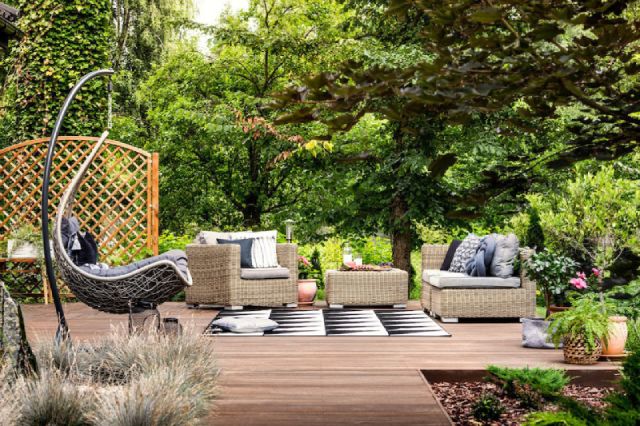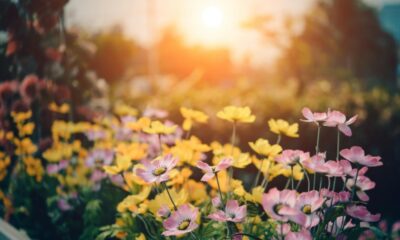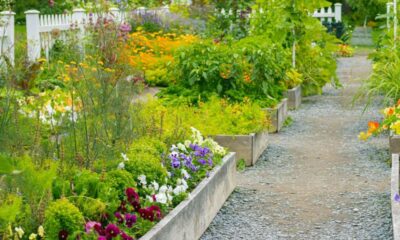Lifestyle
Summertime Landscaping Ideas to Add Glamour to Your Outdoor Space

Summertime is the ideal time of year to spend outside. It’s the ideal time of year to spend outside because of the warm temperatures, longer days, and clear skies. But to get the most out of your outdoor space, you must furnish it with furnishings that are both practical and cozy. That is the role of landscaping. You can make your patio, balcony, or backyard into a lovely and cozy space to unwind, host guests, or have dinner with loved ones with a few easy tips and techniques. We’ll therefore provide some helpful summer landscaping advice to help you make the most of your outdoor space. Well, let’s get going!
How can one design a fantastic outdoor space?
In general, there are two main steps to designing a stunning and useful outdoor space at home.
Evaluate your space
To start designing a fantastic outdoor space, evaluate your current arrangement. Explore your garden, patio, or balcony, and consider how you utilize the area. Think about the following:
- How big is the space you have outside?
- How much shade or sun does it receive?
- Are there any current features, like a deck or a pool?
- How much money do you have?
- Which style do you prefer?
You can decide what adjustments are necessary to create the ideal outdoor space by providing answers to these questions.
Make a landscape plan
It’s time to plan your landscape after you’ve evaluated your space. Make a rough sketch of your outdoor space at first, taking into account any hardscaping, trees, and shrubs that are already there. Next, choose which features, like a garden, a fire pit, a grill, or a seating area, you wish to include.
Best landscaping tips for summer
It’s time to put your landscape design and space assessment into practice by putting some summer landscaping ideas into practice.
Remove the weeds
Summertime and weeds usually go hand in hand. They can appear in your patio, flower beds, and yard, and even squeeze through cracks in your pavers. If you let these troublesome plants grow, your landscape may suffer greatly. Weeds are difficult to pull once they get tall, especially because their roots go deeper. Make sure you remove the roots entirely if you want to get rid of them completely. To stop weeds from spreading further, it is best to treat them when they are small. In addition, if your lawn becomes overgrown, think about applying herbicides to recover control, and revitalize your grass.
Establish a central point
An eye-catching element that piques interest in your outdoor area is called a focal point. It might be a sculpture, a tree, a vibrant plant, or a water feature. You can give your landscape more depth and dimension by establishing a focal point.
Include some shadows
It can get quite hot during the summer, and it can be uncomfortable to spend time in the sun. Take into consideration using a retractable awning, pergola, or umbrella to provide some shade for your outdoor area. It will shield you from damaging UV rays in addition to adding comfort to your area.
To create privacy, use plants
Make your outdoor space more private if it faces a busy street or you have nosy neighbors. Plants are among the greatest tools for this. To establish an organic barrier, pick towering, dense vegetation like bamboo, arborvitae, or evergreen trees.
Properly mow the lawn
A common practice among homeowners is to mow their lawns too short, which unintentionally makes them more vulnerable to heat damage and drought stress. Maintaining a lawn height of 3 to 5.5 inches is advised. Given what most people are used to, this height might seem high. Maintaining a taller lawn can help lower stress levels considerably and encourage a greener, healthier lawn without using too much fertilizer. Taller grass suppresses weed growth, lowering the need for herbicides, and shades the soil, keeping the grassroots cooler and retaining moisture. It is also advisable to leave grass clippings on the lawn. These clippings enrich the soil with organic matter, nitrogen, and moisture. Leaving grass clippings on the lawn for a single season can be as beneficial as applying fertilizer just once. In addition to keeping the lawn in good condition, every mow improves the soil and naturally fertilizes the grass.
Over bare soil, spread organic mulch
A layer of mulch comes in quite handy during the summer’s intense heat. In addition to reducing soil temperature, slowing evaporation, inhibiting weed growth, and improving the visual appeal of your garden, organic mulch has other advantages. Mulch the area around plants with a 2 to 3-inch layer, especially if any bare soil is apparent. Mulch can be used in containers as well. But, keep it away from tree trunks and plant stems to avoid moisture accumulation and the possibility of rot.
Add lighting
Your outdoor space can be made more functional and ambiance-filled with lighting. To light up your landscape, think about installing string lights, path lights, or spotlights. It will enhance the aesthetics of your area and improve accessibility and safety at night.
Include water features
Water features like waterfalls, ponds, and fountains can bring peace and relaxation to your backyard. Additionally, they can draw in wildlife like butterflies and birds, enhancing the landscape’s inherent beauty.
Make a cozy place to sit
Any outdoor space has to have a seating area. Select cozy seating options like hammocks, chairs, or outdoor sofas. Make the area cozier and more welcoming by adding some vibrant outdoor carpets, blankets, and pillows. Remember to set up a little table for snacks and beverages.
Conclusion
With summer just around the corner, improving your outdoor area is a fun project. With these summer landscaping ideas, you can improve your outdoor haven, no matter how big or small your garden is or how big your patio is. Start by evaluating your current configuration, taking into account elements like size, exposure to sunlight, features already in place, budget, and individual style preferences. With this information in hand, design your landscape by adding features like seating areas, foliage, focal points, and ways to provide shade.
-

 Sports4 weeks ago
Sports4 weeks agoFIFA Club World Cup 2025: Complete List of Qualified Teams and Groups
-

 Sports3 weeks ago
Sports3 weeks agoAl Ahly vs Inter Miami, 2025 FIFA Club World Cup – Preview, Prediction, Predicted Lineups and How to Watch
-
Health1 week ago
Back to Roots: Ayurveda Offers Natural Cure for Common Hair Woes
-

 Tech2 weeks ago
Tech2 weeks agoFrom Soil to Silicon: The Rise of Agriculture AI and Drone Innovations in 2025
-

 Sports3 weeks ago
Sports3 weeks agoFIVB Men’s Volleyball Nations League 2025: Full Schedule, Fixtures, Format, Teams, Pools and How to Watch
-

 Startup3 weeks ago
Startup3 weeks agoHow Instagram Is Driving Global Social Media Marketing Trends
-

 Television4 weeks ago
Television4 weeks agoTribeca Festival 2025: Date, Time, Lineups, Performances, Tickets and How to Watch
-

 Sports3 weeks ago
Sports3 weeks agoWorld Judo Championships 2025: Full Schedule, Date, Time, Key Athletes and How to Watch























